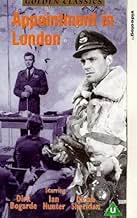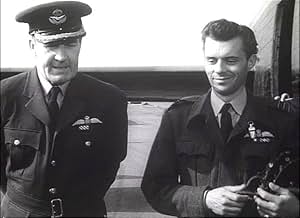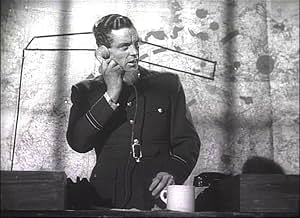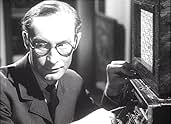Agrega una trama en tu idiomaWar drama about the dangerous and stressful work of Lancaster bomber British crews during World War II.War drama about the dangerous and stressful work of Lancaster bomber British crews during World War II.War drama about the dangerous and stressful work of Lancaster bomber British crews during World War II.
- Dirección
- Guionistas
- Elenco
Opiniones destacadas
I quite love this film. It DOES feel a bit talky because it's predominantly so ground based...but the depiction of Wing Commander Mason's 90th "op" puts it into a class of its own. I love the audio in the raid of the Pathfinder commander...Has such an urgency and veracity which is irresistible. I agree that it's not in the same class as "12 o'clock High"...For me the film Gregory Peck should have won his Oscar for..it truly is a "maxium effort"..but it's an elegant and high quality cinematic testament to the heroism of Bomber-Command. I like too the Aussie pilot played by Bill Kerr in his darker blue RAAF uniform. We Aussies were there in high numbers like so many Commonwealth aircrew who included my Pilot-Officer Uncle Arthur(Nash)shot down with the loss of all in a Wellington bomber on a night raid over Dusseldorf.
This is an unusual film. As others have commented it is well made, tautly scripted and has very good central performances. But that isn't what singles it out.
It's commonly thought that night time area bombing by the RAF was a hit or miss affair, quite different from daylight precision bombing done by the USAAF. Whilst no one can argue that targets were easier to see during daylight hours, both the RAF and the Luftwaffe developed highly accurate methods of hitting their targets at night. In the fateful Dresden raid in February 1945, almost 95% of the RAF bombload fell within one mile of the markers placed with 50 metre accuracy by the Mosquito target illuminator aircraft. The following day, a quarter of the American daylight force sent to follow up bombed Prague, having mistaken one bend in the River Elbe for another.
This film depicts, at length, the method of target marking the flight path using coloured airburst flares, eliminating 'creepback' by approaching the target along different vectors, air and ground marking the target and using a 'Master Bomber' to control the incoming streams and give bomb aimers feedback on accuracy.
No medal was struck for Bomber Command and many of the crew themselves felt their contribution was best forgotten, so this film is one of the few accurate testaments to their courage.
It's commonly thought that night time area bombing by the RAF was a hit or miss affair, quite different from daylight precision bombing done by the USAAF. Whilst no one can argue that targets were easier to see during daylight hours, both the RAF and the Luftwaffe developed highly accurate methods of hitting their targets at night. In the fateful Dresden raid in February 1945, almost 95% of the RAF bombload fell within one mile of the markers placed with 50 metre accuracy by the Mosquito target illuminator aircraft. The following day, a quarter of the American daylight force sent to follow up bombed Prague, having mistaken one bend in the River Elbe for another.
This film depicts, at length, the method of target marking the flight path using coloured airburst flares, eliminating 'creepback' by approaching the target along different vectors, air and ground marking the target and using a 'Master Bomber' to control the incoming streams and give bomb aimers feedback on accuracy.
No medal was struck for Bomber Command and many of the crew themselves felt their contribution was best forgotten, so this film is one of the few accurate testaments to their courage.
"Appointment in London" is an unusually-atmospheric, stylish and very-consistently-interesting late British WWII film. The subject is the pilots of British Bomber Command and the stresses they encounter in battles as the fly Lancasters in night missions over the European mainland. Specifically, the film features as its central character a dedicated pilot, played elegantly by Dirk Bogarde. He has completed 89 missions and survived, but very much wants his 90th. Due to fatigue and concerns for his well being, echelon grounds him. he is angry and frustrated, but during his time on the ground, he reconnects to life and wins lovely Dinah Sheridan, who acts very strongly as the widow of a naval intelligence type, winning her from breezy Willaim Sylvester, a U.S. pilot. The added tension in the film comes from Bogarde's desire to complete his third tour with one final mission, and the fact that everything about it sets up to be a "jinxed" mission from the start. I will not give away the breath-taking and vivid climax, but apart from some leisurely spots here and there, I will claim that director Philip Leacock has produced one of the best of all war films in "Appointment in London" The script was credited to Robert Westerby and John Woolridge, with cinematography by Stephen Dade and art direction by Donald M. Ashton. John Woolridge also wrote the fine original score, and costumes were contributed by Sheila Graham. In appearance, the film is very strongly made, and attractively photographed. The aerial sequences are very good and the recreated picture of wartime London is a big selling point for this hard-to-find film. Bogarde and Sheridan are extraordinarily touching and intelligent; I cannot recommend this film too highly as drama, as a war movie or as a cinematic "sleeper", one which in lesser hands would not have been as absorbing as it was made to be.
This film was also released as APPOINTMENT IN London. Dirk Bogarde is the stalwart star of this wartime drama centered around the lives of the men of a bomber squadron based at Lincoln. A great deal of original aerial footage is edited into the film throughout, culminating in a huge bombing raid over Germany in the latter part of the film, which shows a genuine squadron flying in formation at night, and features the most astonishing real footage of the roaring inferno produced by such a bombing raid. There are also some shots of London in 1952 showing that there was still almost no traffic. Bogarde plays Wing Commander Mason, who at the beginning of the film has flown 87 sorties over Germany and is being urged on all sides to call it quits, but he is determined to go on until he completes 90 missions, because 'I have set my mind on it'. However, he is getting over-tired and everyone worries that he will make mistakes or simply not make it. My wife likes Bogarde a great deal. She used to be taken by her mother to tea with him and his mother in Denham Village when she was a child, when she became entranced by him and his peculiar charm. His mother was apparently rather butch. I only met him and chatted with him on one occasion, at Shepperton. He was certainly a major figure in the history of British cinema. He could be rather waspish, and was no heterosexual. One old friend of ours unexpectedly turned up on the credits of this film, Cecil Ford. He was credited as Assistant Director. I checked IMDb, and he had already been an assistant director for five years by this time. The next year he moved up to Production Manager. Dinah Sheridan plays the love interest in this film. Although everyone thought she was an English rose, Sheridan was really half Russian and half German. She did very well in the part, showing great restraint as 'a widow since Dunkirk' and not falling for the first airman she sees. Everyone in the film is very restrained indeed, and all the upper lips are stiff in the Old Style. This is seriously traditional British fare. Bryan Forbes does very well as an airman who doesn't make it. His wife is played by the interesting actress Anne Leon, who died long ago and made few films. She was very effective, but as she was no glamour gal, it seems she was not offered many parts. It is always a pity when people of talent are not properly recognised. In terms of names we might recognise today, Nigel Stock is uncredited as a co-pilot, not that you would notice. And that is about it. The film was ably directed by Philip Leacock, who went on to make another film with Dirk Bogarde three years later, THE Spanish GARDENER, and later in life was primarily a director of many popular television series. This film is probably about as realistic as you can get, as a portrait of Bomber Command in operation during the War. But it never sacrifices fiction for fact, and maintains strong story lines and dramatic narrative throughout, with all the accuracy serving to make it more moving and authentic.
Some of the best war films have been movies about the Allied bombing campaign of WWII. "Command Decision", "12 O'Clock High" and "Raiders in the Sky" are all excellent films--though the latter is set at a British bomber base whereas the first two are about American bases. While I wouldn't quite put this film in the same level as the other two in quality, it is awfully close and well worth your time.
The film centers around Wing Commander Mason (Dirk Bogarde). He's a very good pilot. However, his 87 missions is wearing on him and he's long overdue to be retired from the front line. Oddly, instead of being happy about this, Mason insists on being able to at least reach 90...and then he'll quit. The film is a nice portrait of Lancaster pilots and crew and because it was made not too long after the war, the filmmakers were able to use three airworthy bombers--which added to the realism.
So why do I think this one isn't quite up to the level of the American films? Well, mostly because Mason just seems to take the whole thing in stride (apart from insomnia) and he seems amazingly well adjusted...taking away from the tension that DID come because the other two films focused so strongly on the emotional toll. Still, a nice tribute to these brave men and well worth your time.
The film centers around Wing Commander Mason (Dirk Bogarde). He's a very good pilot. However, his 87 missions is wearing on him and he's long overdue to be retired from the front line. Oddly, instead of being happy about this, Mason insists on being able to at least reach 90...and then he'll quit. The film is a nice portrait of Lancaster pilots and crew and because it was made not too long after the war, the filmmakers were able to use three airworthy bombers--which added to the realism.
So why do I think this one isn't quite up to the level of the American films? Well, mostly because Mason just seems to take the whole thing in stride (apart from insomnia) and he seems amazingly well adjusted...taking away from the tension that DID come because the other two films focused so strongly on the emotional toll. Still, a nice tribute to these brave men and well worth your time.
¿Sabías que…?
- TriviaThis movie was filmed at R.A.F. Upwood. The Lancasters used were NX673, NX679, and NX782. These aircraft also took part in the filming of The Dam Busters (1955).
- ErroresIn the scene depicting the take off starring Bill Kerr as the Australian pilot, he starts the aircraft up with the phrase "contact port outer". This is incorrect - the Lancaster would have started with the port inner engine as this drove the hydraulics which controlled the turrets etc.
- Créditos curiososClosing credits epilogue: This story is humbly dedicated to all those airmen who were unable to keep an Appointment in London
- ConexionesFeatured in Into the Wind (2011)
Selecciones populares
Inicia sesión para calificar y agrega a la lista de videos para obtener recomendaciones personalizadas
- How long is Raiders in the Sky?Con tecnología de Alexa
Detalles
- Tiempo de ejecución1 hora 36 minutos
- Color
- Relación de aspecto
- 1.37 : 1
Contribuir a esta página
Sugiere una edición o agrega el contenido que falta

Principales brechas de datos
By what name was Appointment in London (1953) officially released in India in English?
Responda




















